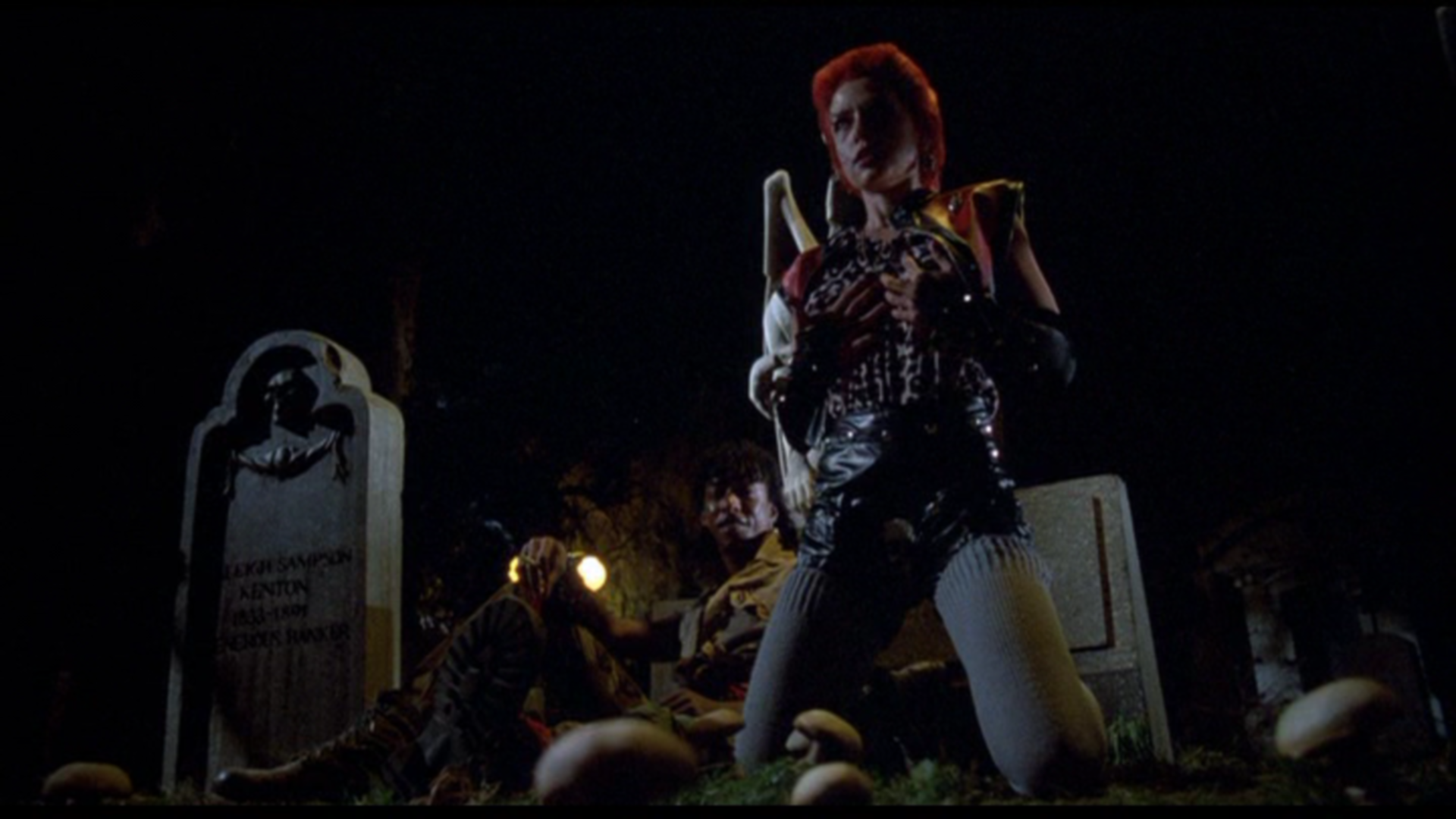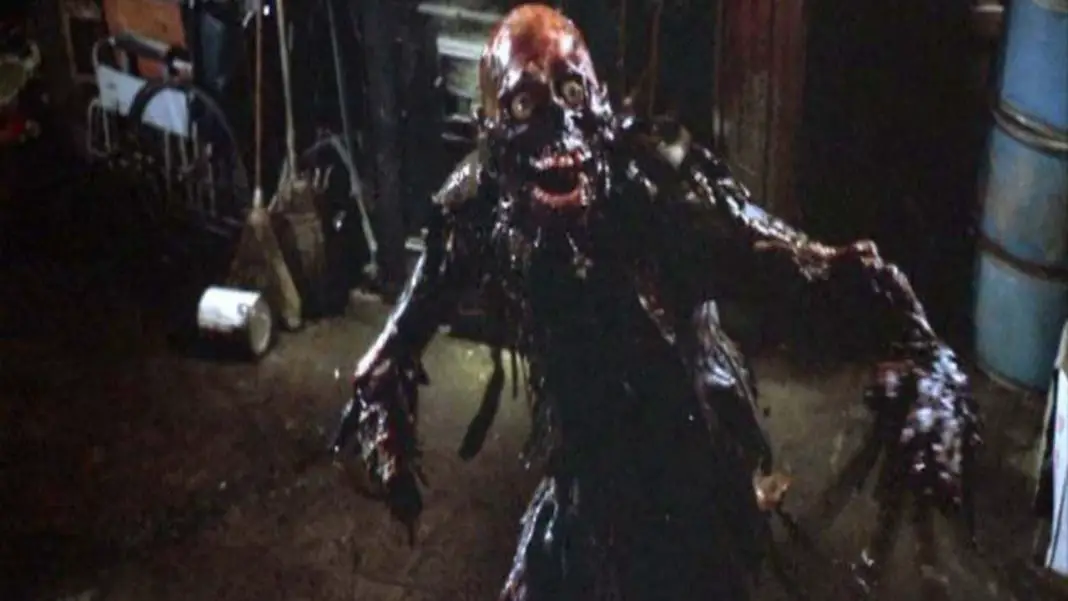Dan O’Bannon’s Return of the Living Dead is, in many ways, the 1980s horror film. It represents everything about the decade boiled down into one complete package. The movie originated after a falling out between co-screenwriters of Night of the Living Dead, George Romero and John Russo, over the rights of the franchise. Romero got the rights to sequels using the “Dead” title, while Russo got the rights to sequels with the “Living Dead” title. He then proceeded to write a novel titled Return of the Living Dead, a sequel to his original screenplay. When the film was optioned, it was decided to take it in another direction. That ultimately worked out for the best. The Return of the Living Dead that wound up on the screen is not a sequel to Night of the Living Dead, it’s a deconstruction. This film tears apart that predecessor and reassembles the pieces into something completely different.
The plot of Return of the Living Dead is fairly straightforward. Frank introduces his nephew Freddie to his first day at the UNEEDA Medical Supply Warehouse, he tells Freddie that Night of the Living Dead was based on actual events (completely different from the movie) and the corpses from that event were shipped to this warehouse by mistake. They investigate, cause a gas leak trying to bust open one of the canisters, and unleash a zombie outbreak.


The cast of characters making up the film represent a true mix of 1980’s teenagers. There are preppy kids and totally decked-out punks. It’s actually impressive how much characterization there is for such a large cast. Every one of these teenagers has a different personality. These aren’t punks in the tradition that was common for the ’80s, where if a character was ‘punk’ they had dyed hair. These characters had that, but they also had mohawks, faux-hawkes, leather, piercings, chains and names like Trash, Spider, and Suicide. This movie went all the way with its interpretation of punks and even went a step further than that by making them the main characters. The untrusting Spider and death-obsessed Trash may be abrasive, but they become surprisingly easy characters to root for. At the very least, we don’t want them to be eaten.
Leading the “adult” cast are Clu Gulager’s Burt, Don Calfa’s Ernie and James Karen’s Frank. These characters tap into something very common for 1980s teens: The mistrust of authority. Now, Burt and Ernie and Frank are not bad characters, they’re definitely not antagonists, but they’re responsible for some of what’s going on and they don’t want to report the incident immediately because it will be terrible for business and they have no idea how to handle the situation. Their attempts to cover it up and dispose of it quickly only make things much, much worse. This all plays into the belief of kids at the time that authority figures were not to be trusted, that they were totally inept, and if there’s anyone in the movie who has a handle on the situation and a level head about it, it’s Spider.
Return of the Living Dead is counter-culture to its core. It’s a visual representation in the characters and their costuming as well as the graffiti-covered locations. At the same time, it is a total representation of the nihilism of the decade. These zombies are much different than Romero’s–as well as pretty much any zombies before or since. These zombies have some degree of intelligence (as showcased by their ability to use the radio to call for more paramedics after eating all of them) and they’re fast. Long before 28 Days Later, this was the origin of fast zombies. They simply can’t be killed. The only way to take them out is to completely burn the bodies to smoke, but this smoke mixes with rain and only leads to the creation of more zombies. Once they’re dead, they cannot die again. In addition to all of that, these zombies are sentient and self-aware after death. During an interrogation scene, one zombie reveals that they feel the entire process of death from rigor mortis down through every stage of decomposition. This is the absolute worst-case scenario. It’s as bad as it can get. Which makes the movie’s approach to these details all the more brilliant.
The film is often cited as one of the best horror comedies of all time. All the details are terrible, the characters aren’t particularly loving life, and yet the movie simply couldn’t be funnier. The tone and the approach to humor is what makes the entire ordeal work. Because the goal of punk rock isn’t to simply say “the end is here.” The goal is to say “the end is here, there’s nothing we can do about it, so we might as well have some fun with it.”
The movie is insanely funny. The characters are killed off in gruesome ways, but not ways that could really be taken seriously. The gore is cartoonish, pure splatter art. It revels in its overbearing sense of doom. The movie builds to an ending that’s really the only ending this film could possibly have. After refusing to call the number on the canister originally, they eventually contact the army, who promise the situation will be dealt with. In the perfect capper on theme of mistrusting authority, trusting in the army proves to be a death sentence. The army promises a rescue team is on the way, and instead uses the coordinates they’re given to nuke the entire town. But of course the smoke from the explosion mixes with rain and is hinted to cause a new outbreak and start the whole problem over again.
Return of the Living Dead represents the time, the culture and the mindset of the mid-1980s better than maybe any other horror film. It’s as smart as it is insanely entertaining and quotable. As the film itself suggests, it is more than simply a costume, it’s a way of life.
Follow us on social media: Twitter and Facebook
Post Views:
1,412


